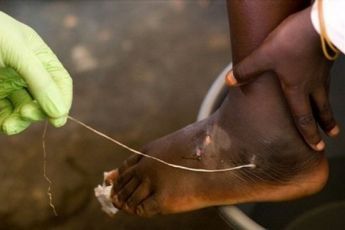South Sudan: Pastoralists threaten Guinea worm elimination
By Julius N. Uma
June 22, 2010 (JUBA) — The mass movement of pastoralists in search for pastures threatens efforts to eliminate Guinea worn in the semi-autonomous region, officials from Southern Sudan Guinea Worm Eradication Program (SSGWEP) have disclosed.

“There’s no way we can succeed in interrupting transmission of Guinea worm disease without taking into account the movements of the cattle, and thus of villagers, between their permanent locations and the cattle camps,” Mr. Yibi said.
SSGWEP is, hitherto, working in partnership with the Carter center to get rid of the disease in Southern Sudan, where 85 percent of the world’s remaining 3,190 cases were reported in 2009.
Sudan is an arid country with distinct dry and rainy seasons. However, when water becomes scarce during the prolonged dry period, pastoralists migrate with their livestock to graze in wetter areas, often near the edge of the Nile River.
“Along the journey, they [pastoralists] may traverse territories belonging to others, which can spark conflicts over grazing rights or other issues. Before the rainy season returns, the nomadic herdsmen lead their families and animals back to their base villages,” further noted SSGWEP Director.
Meanwhile, challenges were also reported in Guinea worm surveillance activities, mainly cited among those clans that come together and move in elusive camp formations during the dry season.
“Patients on the move also make it harder for the program to care for their wounds and ensure new water sources are not being contaminated,” Mr. Yibi said.
WHAT IS GUINEA WORM DISEASE?
Wikipedia, the online encyclopedia defines Guinea worm disease a parasitic infection caused by a long and very thin nematode (Dracunculus medinensis). The infection reportedly begins when a person drinks stagnant water contaminated with microscopic “water fleas” harboring the larvae of the guinea worm.
Approximately one year later, the disease presents with a painful, burning sensation as the worm forms a blister, usually on the lower limb. Once prevalent in 20 nations in Asia and Africa, the disease remains endemic in only four countries in Africa.
Historically, the Guinea worm is reportedly one of the best documented human parasites, with tales of its behavior reaching as far back as the second century BC. While, the common name “Guinea worm” is said to have appeared after Europeans first saw the disease on the Guinea coast of West Africa in the 17th century.
(ST)

BUSTA 2
South Sudan: Pastoralists threaten Guinea worm elimination
Jungle is full of all types of Disease!!!!
The Might Equatorian will never have such disgusting type of disease just look how terrible the worm is looking!!
Why are they moving up and down? Let them settle down with their so called cattle than disturbing people.
Brother in Christ,
Busta 2
julius mowanga
South Sudan: Pastoralists threaten Guinea worm elimination
Dinka Boy is suffering of the Guinea Worm,he wil be around the barn tomorow if he managed to suck enough swines blood to avert the sideaffects of the mental deterioration caused by the worms’ brain contamination..
RAHELA GARANG
South Sudan: Pastoralists threaten Guinea worm elimination
Eeeew!!!! that picture is so dreadful. It’s gonna take some time to eradicate the worm, perhaps with good public education and introduction of safe drinking water in the area.